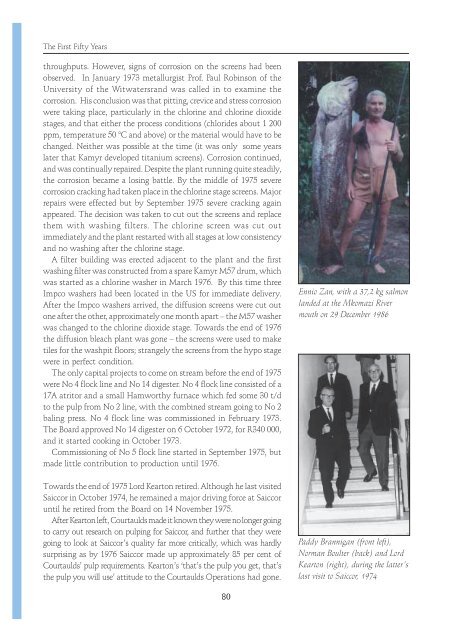Create successful ePaper yourself
Turn your PDF publications into a flip-book with our unique Google optimized e-Paper software.
<strong>The</strong> <strong>First</strong> Fifty <strong>Years</strong><br />
throughputs� However, signs of corrosion on the screens had been<br />
observed� In January 1973 metallurgist Prof� Paul Robinson of the<br />
University of the Witwatersrand was called in to examine the<br />
corrosion� His conclusion was that pitting, crevice and stress corrosion<br />
were taking place, particularly in the chlorine and chlorine dioxide<br />
stages, and that either the process conditions (chlorides about 1 200<br />
ppm, temperature <strong>50</strong> °C and above) or the material would have to be<br />
changed� Neither was possible at the time (it was only some years<br />
later that Kamyr developed titanium screens)� Corrosion continued,<br />
and was continually repaired� Despite the plant running quite steadily,<br />
the corrosion became a losing battle� By the middle of 1975 severe<br />
corrosion cracking had taken place in the chlorine stage screens� Major<br />
repairs were effected but by September 1975 severe cracking again<br />
appeared� <strong>The</strong> decision was taken to cut out the screens and replace<br />
them with washing filters� <strong>The</strong> chlorine screen was cut out<br />
immediately and the plant restarted with all stages at low consistency<br />
and no washing after the chlorine stage�<br />
A filter building was erected adjacent to the plant and the first<br />
washing filter was constructed from a spare Kamyr M57 drum, which<br />
was started as a chlorine washer in March 1976� By this time three<br />
Impco washers had been located in the US for immediate delivery�<br />
After the Impco washers arrived, the diffusion screens were cut out<br />
one after the other, approximately one month apart – the M57 washer<br />
was changed to the chlorine dioxide stage� Towards the end of 1976<br />
the diffusion bleach plant was gone – the screens were used to make<br />
tiles for the washpit floors; strangely the screens from the hypo stage<br />
were in perfect condition�<br />
<strong>The</strong> only capital projects to come on stream before the end of 1975<br />
were No 4 flock line and No 14 digester� No 4 flock line consisted of a<br />
17A atritor and a small Hamworthy furnace which fed some 30 t/d<br />
to the pulp from No 2 line, with the combined stream going to No 2<br />
baling press� No 4 flock line was commissioned in February 1973�<br />
<strong>The</strong> Board approved No 14 digester on 6 October 1972, for R340 000,<br />
and it started cooking in October 1973�<br />
Commissioning of No 5 flock line started in September 1975, but<br />
made little contribution to production until 1976�<br />
Towards the end of 1975 Lord Kearton retired� Although he last visited<br />
<strong>Saiccor</strong> in October 1974, he remained a major driving force at <strong>Saiccor</strong><br />
until he retired from the Board on 14 November 1975�<br />
After Kearton left, Courtaulds made it known they were no longer going<br />
to carry out research on pulping for <strong>Saiccor</strong>, and further that they were<br />
going to look at <strong>Saiccor</strong>’s quality far more critically, which was hardly<br />
surprising as by 1976 <strong>Saiccor</strong> made up approximately 85 per cent of<br />
Courtaulds’ pulp requirements� Kearton’s ‘that’s the pulp you get, that’s<br />
the pulp you will use’ attitude to the Courtaulds Operations had gone�<br />
80<br />
Ennio Zan, with a 37,2 kg salmon<br />
landed at the Mkomazi River<br />
mouth on 29 December 1986<br />
Paddy Brannigan (front left),<br />
Norman Boulter (back) and Lord<br />
Kearton (right), during the latter’s<br />
last visit to <strong>Saiccor</strong>, 1974

















